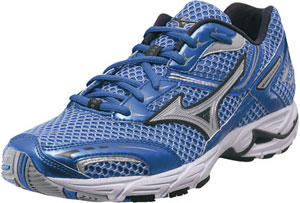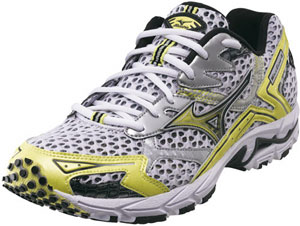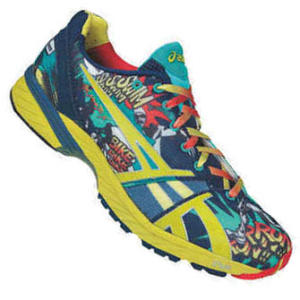
[Editor’s note: Our capable editor-at-large for footwear Jeroen van Geelen owns Total Running, one of the more important running and triathlon retail establishments in The Netherlands.]
In this next part on Lightweight Trainers I will review Adidas, New Balance and Mizuno.
Adidas
This august Germany company is a behemoth, making shoes for athletes in sports many people have never heard of. It has not paid attention to triathlon the way other footwear brands have, and the same might be said of its posture toward the broader category of technical (road) running. But it’s redoubled its efforts as of late, and we present part of its 09 lineup here.

Adizero Adios
It's only right to start with this shoe (pictured adjacent) since this is the world record breaking shoe Haile Gebreselassie ran in during his Berlin marathon 2008 race. This shoe is exceptionally light, it's fast but its still has enough cushioning even when you are not built like the diminutive Gebreselassie. It fits perfectly in the heel, it's got a very lightweight mesh upper and it's in a bright yellow color. The shoes are very responsive and feel like you can only run in them fast.
It's a pity for us triathletes that they didn't bring this out with the Velcro closure system like they do on the Adizero LT+ (to add another Adizero model to the range). That would make it the ultimate triathlon shoe. The upper is narrow but not too narrow. It fits just right on most feet; but those who like a roomier toe box or who have wide feet might take exception.
Adizero shoes all fit a bit low around the maleolus (the cathy bates bone), which makes them feel even lighter than they are. This shoe is so light it should be used only once a week and only by experienced athletes. I could easily put this shoe in the racing flat category with a weight of 7.8 oz.
If you are a neutral, not too heavy, triathlete—and you like yellow—you should try them out. I personally will run in these with the Ironman branded Total Support insoles from Spenco.
The Adizero Adios is not available in a specific women's last, but is available starting in men’s size 5.

Adizero Mana
These shoes, pictured adjacent, are a lot like the Adios but with a slightly different midsole. There is a little less Adiprene material in the heel of the shoe which makes it feel a bit harder, particularly for heel strikers. Two of the three Adidas brand stripes on the side of the shoes are connected directly to the laces, and it laces up a bit higher around the ankle. These features aid athletes with lower arched or flatter feet. The mesh upper is also, as in the Adios, very lightweight. The Mana is made with a medial post so it gives a bit more stability—in comparison to the Adios—for athletes with slight to moderate pronation. The Mana tips the scale at 7.6 oz.
The Adizero Mana is available in male- and female-specific lasts. Colors in the men’s and wome’sn models are the same.

Adizero Ace
The Ace (pic of the women's version is alongside) is a lightweight trainer that gives a reasonable amount of cushioning and stability in a neutral shoe. The midsole is a little thicker than with the Adios and the Mana, but a bit extra in the heel. This, for those whose calves and Achilles tendons need a bit more cushion than offered by the Adios or the Mana. The fit is, like almost all Adidas models, on the narrow side. The lining in all Adidas shoes is made from a non-slippery material which works well, even when running without socks.
This shoe is suitable for neutral runners who like a bit more cushioning and who like to feel a bit more shoe surrounding their feet. The Adizero Ace is available in specific male and women lasts. Colors are the same in the men’s and women’s models. The weight in a men's size 9 is 7.3 oz.
Adizero Boston
The Boston’s fit is more like that of the Adios—a little lower around the ankle. Also, the upper is from the same lightweight mesh. The big difference between the models is that the Boston has the “thickest” midsole in the lightweight trainers range from Adidas. Its weight is 9.7 oz. The heel is about the same as in the Ace but the forefoot is beefed up with some extra cushioning as well as some durability due to the use of blown rubber on the outsole rather than the lighter Adidas Quickstrike, which is used on the Adios and the Ace.
It would have been nice to see this model with a medial post; Adidas would have created a nice balance between its neutral and more supportive models. Too bad they didn't. This is to my opinion a missed opportunity, since they now have three neutral models—pretty close to each other—and only one model (the Mana) with some added support.
The Boston is also available in a womens-specific model in the same color as the men’s version.
There are no features that make the Adizero range tri-specific, not that this is necessary. If you like the shoes and you want a faster transition, it’s up to you to add Lace Locks, Yankz!, or similar fast closure system.
New Balance
New Balance makes some excellent lightweight trainers, but they have a bit of an image problem. For years NB has been known as the brand for heavy runners with wide feet—remember this is the brand famous for width sizing. The shoes also routinely feature blander colors like navy, brown, black and grey. They still offer shoes such as the M458, and the M587, which further this image.
M904 and W 904
But in recent years NB introduced lighter, more sophisticated materials. And with success. This year the 903 was the Editor's Choice of Runners World magazine.
For 2009 they updated the model slightly but significantly. They didn't change a lot on the outsole and midsole. The big change is in the upper. The 903 was made with an almost-mesh upper with almost no supporting layers in the shoe. In the 904 they use again lightweight mesh, but not on the interior or exterior midfoot. Here they use a somewhat more supportive material so, in combination with NB N-Lock system, the shoe gives more support to your midfoot.
The N-Lock is the NB “N” on each side of the shoe with 2 straps running through this “N”, ending in lace loops. So as soon as you lace up, the shoe will automatically get tighter if you pull a bit on the laces in this part of the shoe. This model has a larger medial post than most other lightweight trainers and the outsole is full length on the medial side of the shoe, which also creates some extra stability. At a weight lighter than 10 oz this makes the NB 904 a very good shoe for athletes with slight to moderate pronation.
It’s available in different widths and in specific men (M904) women (W904) versions.
M827 and W827
The NB827 looks a lot like the 904 but without the medial post. This is a neutral lightweight trainer with very good cushioning at a weight of 9.6 oz. To get to this weight they made the upper almost completely from lightweight and breathable mesh. To get a bit of support in the midfoot area they use the N-Lock system as explained above. The shoe could be even lighter but NB chose to use the Acteva LITE midsole material instead of the lighter and more expensive Acteva Ultra LITE in this model. In my opinion they did this model short on using this heavier material in a lightweight shoe.
This model is also available in different widths, and the M and W in M827 and W827 signify gender.

Mizuno
First, a short intro on the Mizuno Wave technology they use in their models, so you understand what makes Mizuno shoes different than most other brands.
It took a long time for Mizuno to get accepted as a real running brand. They struggled a long time with models that just weren't good enough for different reasons on different models. It all changed when they introduced the Wave technology, a plate that separates the midsole of the shoe into upper and lower segments. The Wave plate can be made with different hardnesses and shapes of “waves” on the inside and outside. These waves can make shoes more neutral or stable without adding a medial post.
In other shoes, the absence of a medial post means you’re dealing with a neutral shoe. Not so with Mizuno. None of its shoes have medial posting per se, but changing the shape of the wave works like a medial post. A shoe with a Wave plate with evenly shaped waves on the medial and lateral side is a neutral shoe.
Wave Precision 9
This, pictured just above, is Mizuno's top lightweight trainer. In this model Mizuno uses its proprietary Acceleration Polymer. The shoe is fast and reactive, but not suitable for athletes who like a softer ride. Due to this harder midsole there is little energy lost as will happen in a softer shoe. The shoe feels light and stable at a weight of almost 10 oz. The upper is made of lightweight breathable mesh, but the big feature is this shoe’s Wave plate. In the Precision the Wave plate is made of rubber, to keep the from feeling hard. It has a so-called parallel Wave, which means that it is of the same shape on the medial and lateral side of the midsole. On the medial side they add a midfoot shank to give the shoe a bit of extra torsional support.

This makes the shoe suitable for neutral to slight pronators and for midfoot strikers. In my experience most high-arched athletes prefer this above other Mizuno models.
Wave Elixer
The Elixer (men’s version is adjacent, women’s is the lead photo at the top of the article) is similar to the Precision 9. Same midsole material; different Wave plate.
The Wave plate in the Elixer is built from 2 different materials. The lateral side is rubber; the medial side is out of a harder synthetic material. Also the waves are different in shape. The medial side is build with 2 curves and the lateral side with one curve, which makes this shoe suitable for athletes who need a bit more structure. Mizuno uses G3 layered outsole technology under the forefoot. This is a lightweight traction material that keeps the weight down. Although they say it’s durable enough I’ve found this claim debatable. The Elixer fits a slightly wider foot than does the Precision 9, and the weight is 10.3 oz.
Wave Aero 7
This sub-9oz shoe is the lightest of these 3 Mizuno models, in racing flat territory. But their cushioning is sufficient for serious speed training once a week. The Aero 7 uses the same Acceleration Polymer midsole as in the other models, but it feels slightly softer.
The fit is narrow in the midfoot but still roomy enough in the toe box for most of us. The Wave plate is out of rubber, as in the Precision, but instead of 1 curve this model has 2 slight curves. Lateral and medial sides are the same. The Aero 7 is suitable for the lighter, more experienced athletes with no biomechanical efficiencies.
All models are available in men's and women's versions.
[If you like what Jeroen has written for our Slowtwitch readers, and if the Netherlands is a convenient country from which to buy, most of these shoes can be purchased at Jeroen's click and mortar store: Total Running.]


